23 - magnetic fields
1/35
There's no tags or description
Looks like no tags are added yet.
Name | Mastery | Learn | Test | Matching | Spaced |
|---|
No study sessions yet.
36 Terms
define magnetic field
A region surrounding a permanent magnet or a current carrying conductor in which magnetic objects experience a force
What do the direction of the arrows on the magnetic field lines show
the direction in which a free north pole would move
in terms of magnetism, what happens when a wire carries a current
explain how this happens
A magnetic field is created around the wire
The field is created by the electrons moving within the wire, as any charged particle that moves creates a magnetic field in the space around it
Explain the magnetic field for a current-carrying conductor
and the rule used to find the direction of the magnetic field
The magnetic field lines are concentric circles centred on the wire and perpendicular to it
- direction can be determined using right hand grip rule, where thumb is direction of current and fingers curl around wire in direction of magentic field
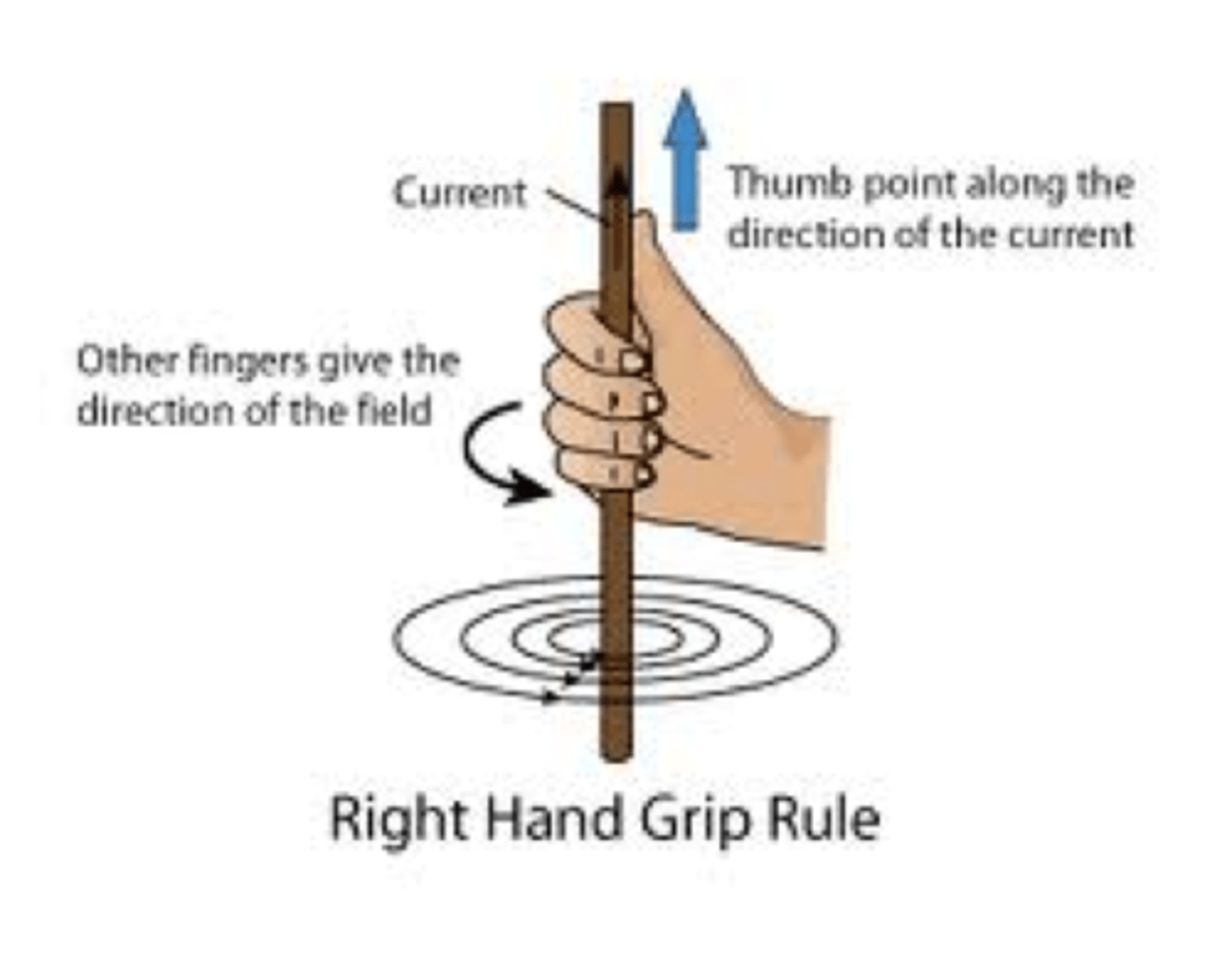
Explain the magnetic field for a solenoid
How can you use the right hand grip rule to find the dirceiton of the magnetic field
At the centre of the core of the solenoid, it is uniform
outside of the coil, it is similar to a bar magnet
- using right-hand rule, thumb points in the direction of the magnetic field and fingers curl in direction of current
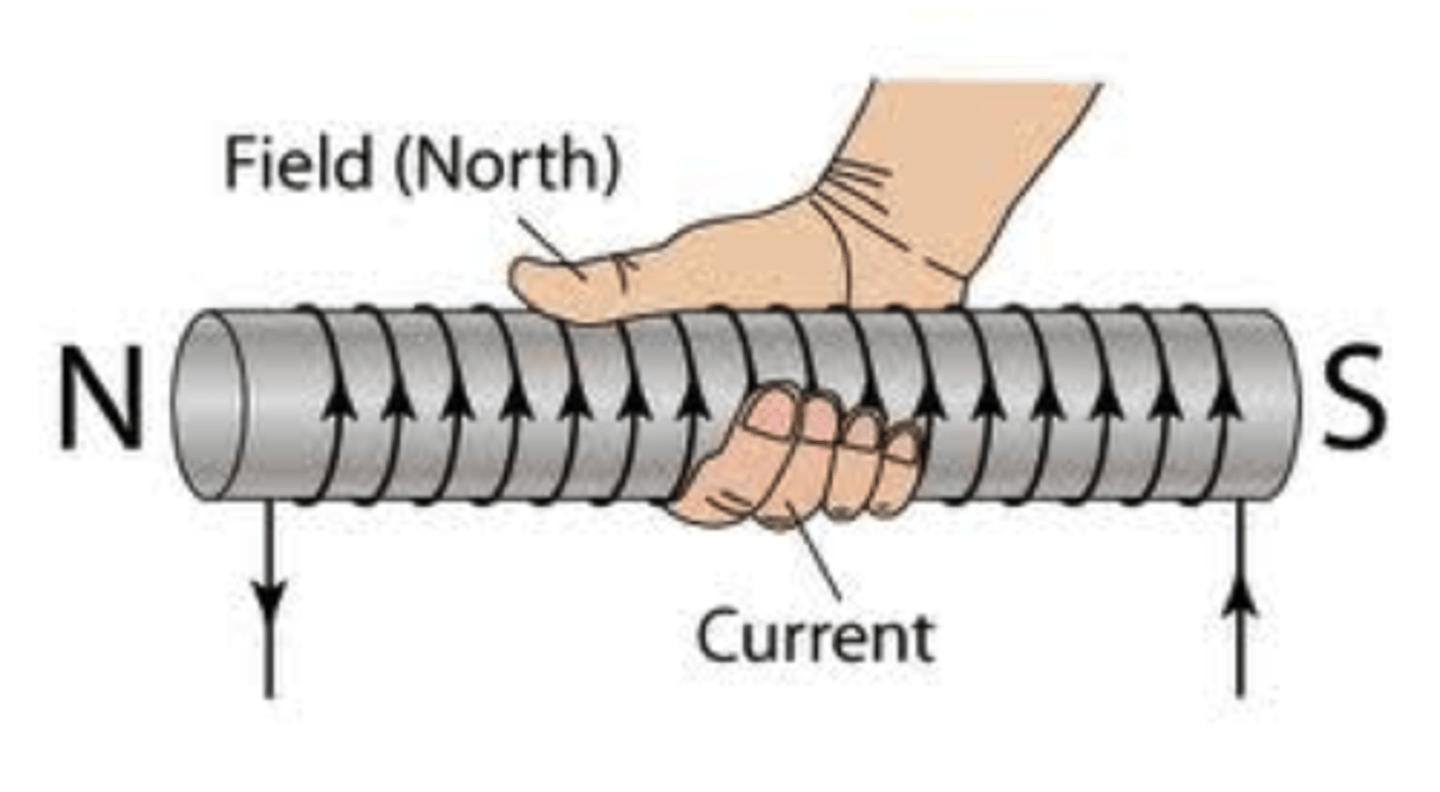
What happens when a wire has a current in an external magnetic field?
what rule can be used in this situation?
The field around the wire and the external magnetic field will interact, causing a force on the wire.
The magnet creating the external magnetic field will also experience an equal and opposite force due to Newton's 3rd law
Fleming's left hand rule can determine the direction of this force:
= FBI
- F = force
- B = magnetic flux density
- I = current
What is magnetic flux density
vector or scalar?
unit ?
The force on one metre of wire carrying a current of one amp at right angles to the magnetic field
- it is a measure of the strength of a magnetic field
- it is a vector
- unit: Tesla (T)
for a current carrying conductor in an external magnetic field, what quantities is the force proportional to and therefore, what is the formula
- length of wire
- Current in wire
- Magnetic flux density
- 𝛳 between the magnetic field and the direction of current
∴ F=BILSin𝛳
design an experiment to determine magnetic flux density
- connect the wire to the circuit with an ammeter and variable resistor with a crocodile clip and keep it taught with a clamp stand on either end
- place magnets on top of a balance and set it to zero
- ensure the wire is perpendicular to the magnetic field
- measure the length of wire in the magnetic field
- turn on the power supply
- current will experience a force upwards (Flemmings left-hand rule)
- due to newtons 3rd law of motion, the magnets experience an equal downward force, F, causing a change in the mass reading
- using F=mg, force can be calculated
- vary the current using the variable resistor and record corresponding values for the force
- plot F against I where m = BL
- L determined at the beginning ∴can get B

when is the force on a current carrying conductor at its maximum when in an external magnetic field?
when sin𝛳 = 1
so 𝛳 = 90°
so when current is perpendicular to direction of magnetic field
what happens to a beam of electrons in a magnetic field moving perpendicular to to the field?
each electron experiences a force, F=BILSin𝛳 where 𝛳=90°
The force will be perpendicular to its velocity and the magnetic field
why does a current carrying wire experience a force in an external uniform magnetic field
each electron moving within wire experiences a tiny force
how would you find the force exerted on a single charged particle moving in a magnetic field?
F=BIL
L = vt (v=speed of electrons, t = time to travel L metes)
F=BIvt
Q = It, NQ = It, I = NQ/t
F = B(NQ/t)(vt)
F = BNQv
force on each particle → F = (BNQv)/N
→ F = BQv
where f = force
B = magetic flux density
Q = charge
v = initial perpendicular velocity
how does a magnetic force on a charged particle moving through its magnetic field link to circular motion
the particle will experience a force perpendicular to its velocity
- this force can also act as a centripetal force
∴ F=BQv, F=mv²/r
what is a velocity selector
A device that uses both electric and magnetic fields to select charged particles of specific velocity
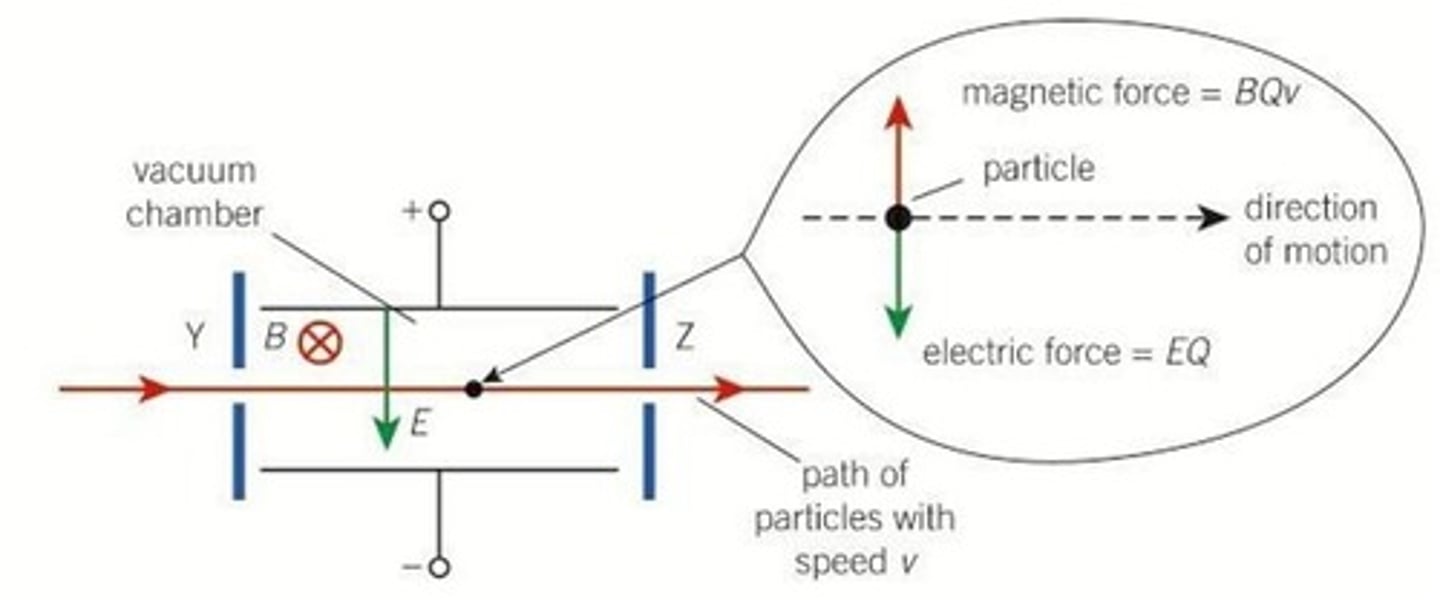
how does a velocity selector work?
two parallel plates connected to power supply produce a uniform electric field of strength E between plates
uniform magnetic field of fluc density B is applied perpendicular to electric field
charged particles at different speeds enter through a slit
electric field and magnetic field deflect them in opposite directions, but only particles with a specific velocity will these deflections cancel so that they travel in a straight line, passing through the velocity selector
for these particles, EQ = BQv
∴ v = E/B
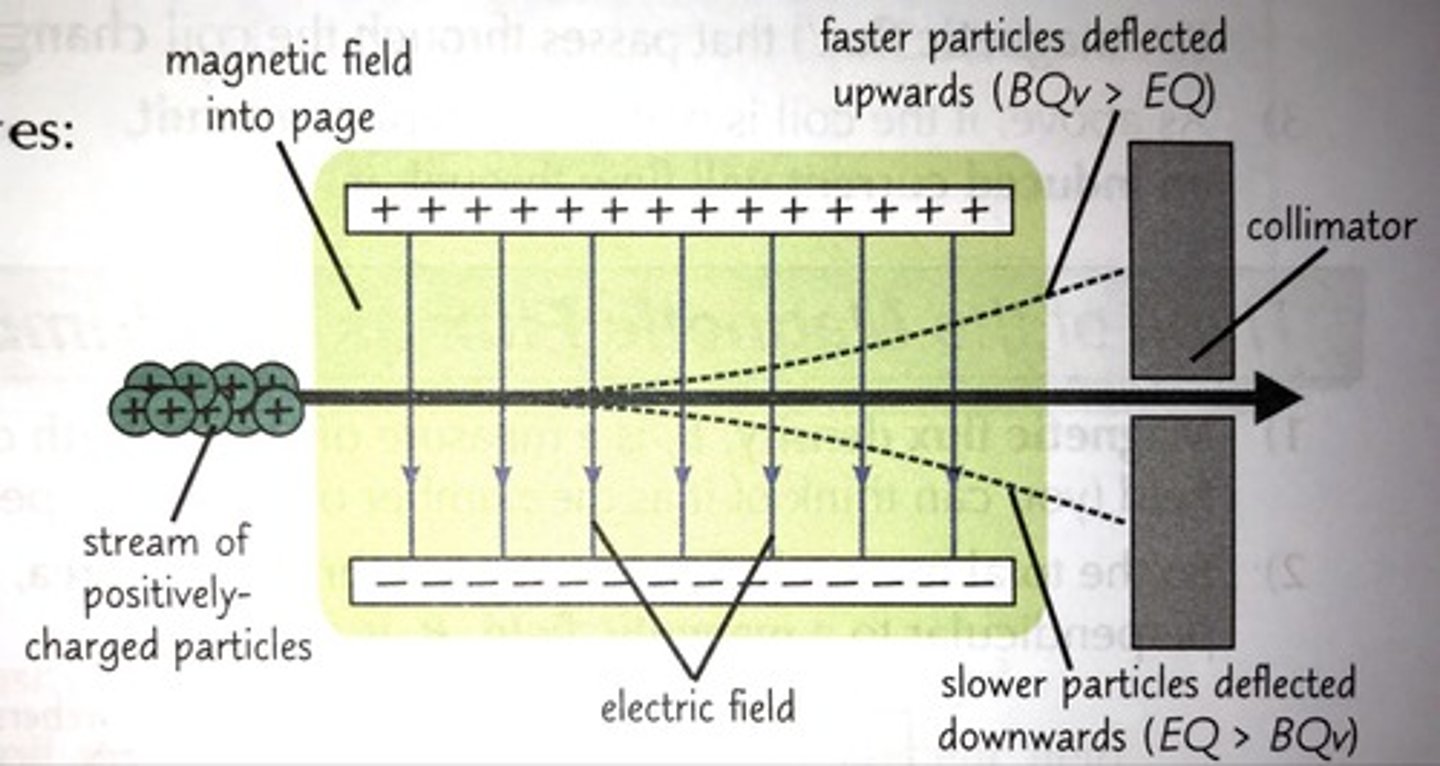
Define magnetic flux ɸ
formula?
The product of the component of the magnetic flux density perpendicular to the area and the cross-sectional area
ɸ = BACos𝛳
where B = magnetic flux density
A = cross-sectional area of the loop
𝛳 = angle between the magnetic field and the normal to the surface of the loop
ɸ = magnetic flux, Weber (Wb)
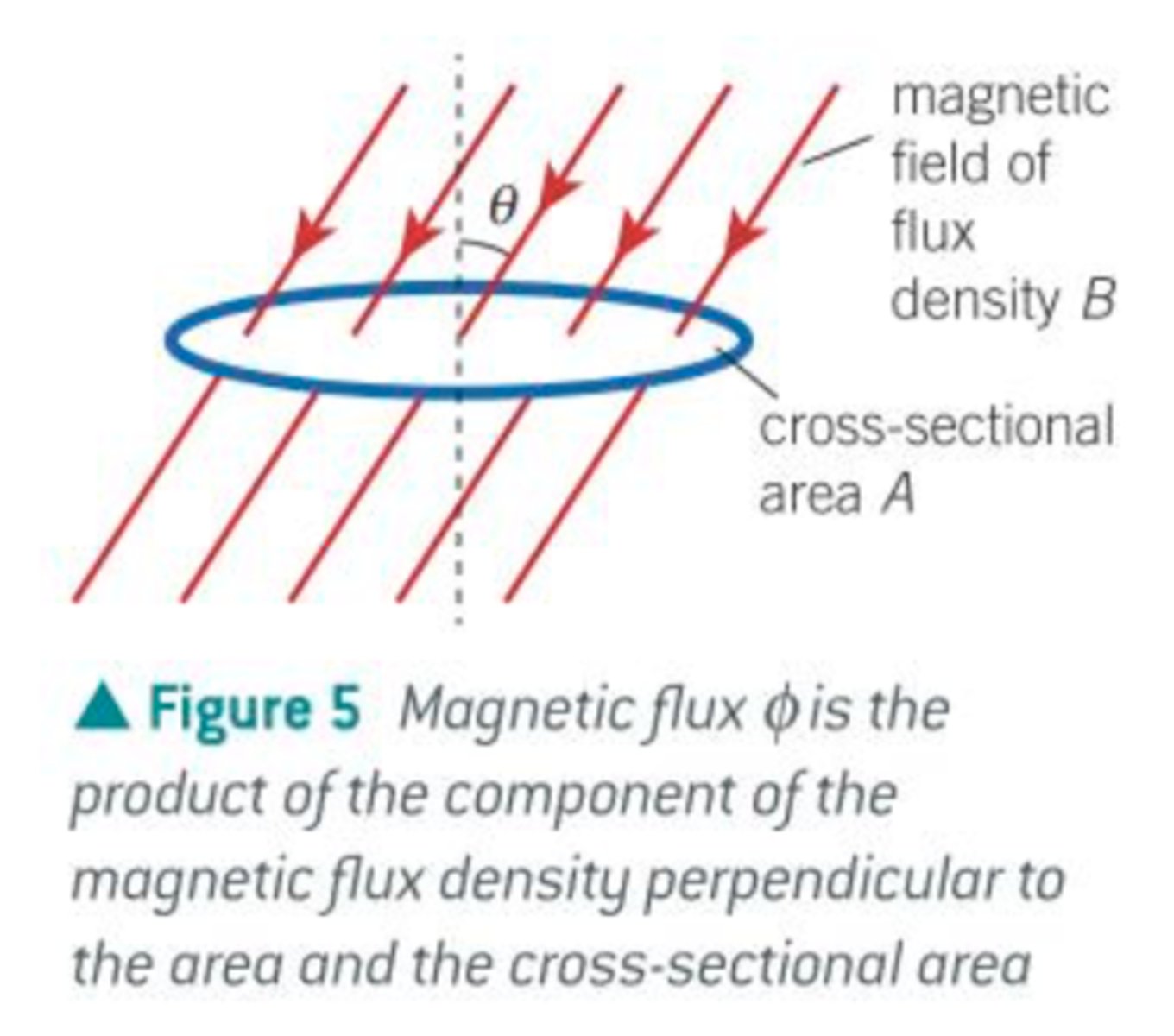
in simple terms, what is magnetic flux density and so what is magnetic flux?
and so what is magnetic flux linkage
magnetic flux density is a measure of the strength of the magnetic field per unit area (B = ɸ/A)
- the total magnetic flux, the total magnetic flux density in the area (ɸ = BA)
- when the magnetic flux is not perpendicular to the area of the coil, you use trig (ɸ = BACos𝛳)
- the flux linkage is just the flux multiplied by the number of coils (Nɸ) if you have more than one coil
Define magnetic flux linkage
formula
the product of the number of turns in the coil, N, and the magnetic flux
Nɸ
- Weber (Wb)
- also called weber-turns
how can you induce an emf
An emf is induced in a circuit whenever there is a change in the magnetic flux linking the circuit
△ɸ = BACos𝛳
∴ You can induce emf by changing B, A, or 𝛳
What is Faraday's Law?
The magnitude of the induced e.m.f. is directly proportional to the rate of change of magnetic flux linkage
𝜀 ∝ Δ(Nɸ)/Δt
What is Lenz's law?
the direction of the induced e.m.f. or current is always such as to oppose the change producing it
so, what is the formula combined from Faraday's and Lenz's law?
what is the constant of proportionality
𝜀 = -Δ(Nɸ)/Δt
constant of proportionality is negative 1
Explain Lenz's Law in terms of energy
Lenz's law follows the principle of the conservation of energy. If the induced emf was in a direction that aided the change which caused it, it would be creating electrical energy from nowhere.
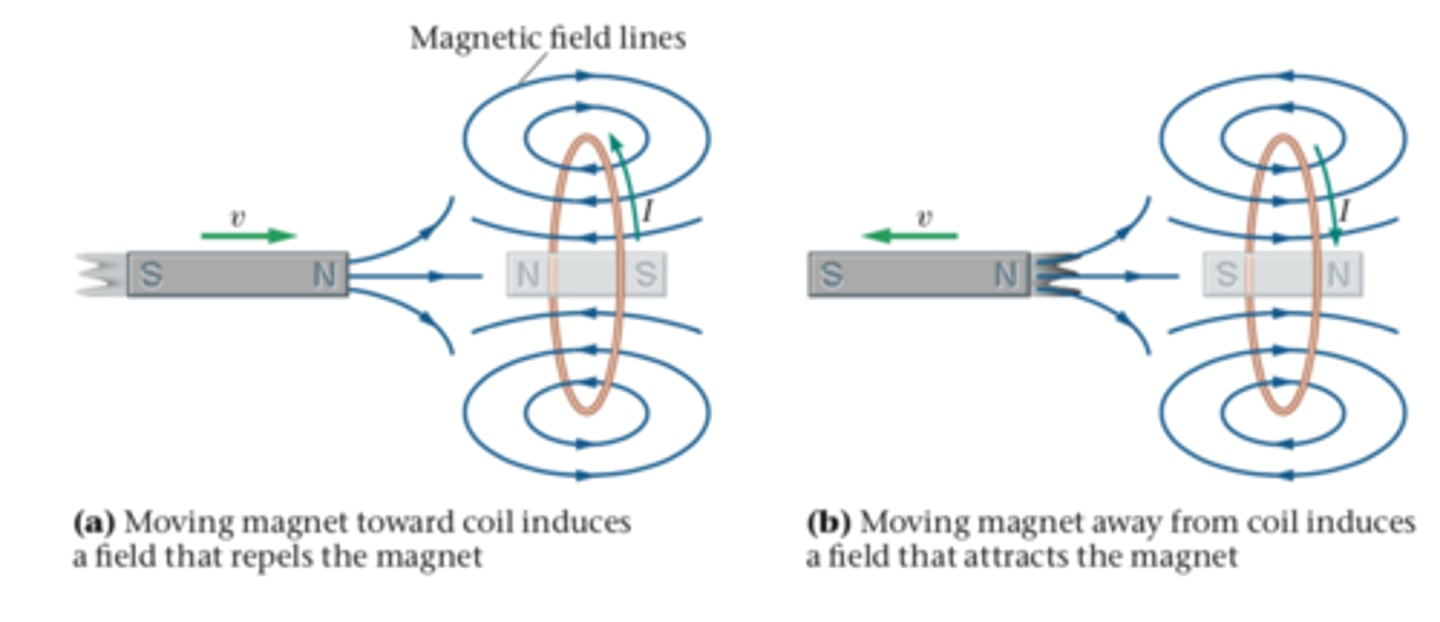
explain how an alternating current generator works
- a coil of wire rotating in a magnetic field
- changing magnetic flux through the coil induced an alternating emf
- slip rings and brushes allow the coil to remain in contact with the rest of the circuit
- coil rotates due to external mechanical means, changing the magnetic flux linkage through the coil
- according to Faraday's law, an emf is induced whenever there is a change in magnetic flux linkage: 𝜀 = -Δ(Nɸ)/Δt
- as the coil rotates at a steady frequency, the flux linkage changes with time caused by the changes in 𝛳
- this induces an alternating e.m.f.
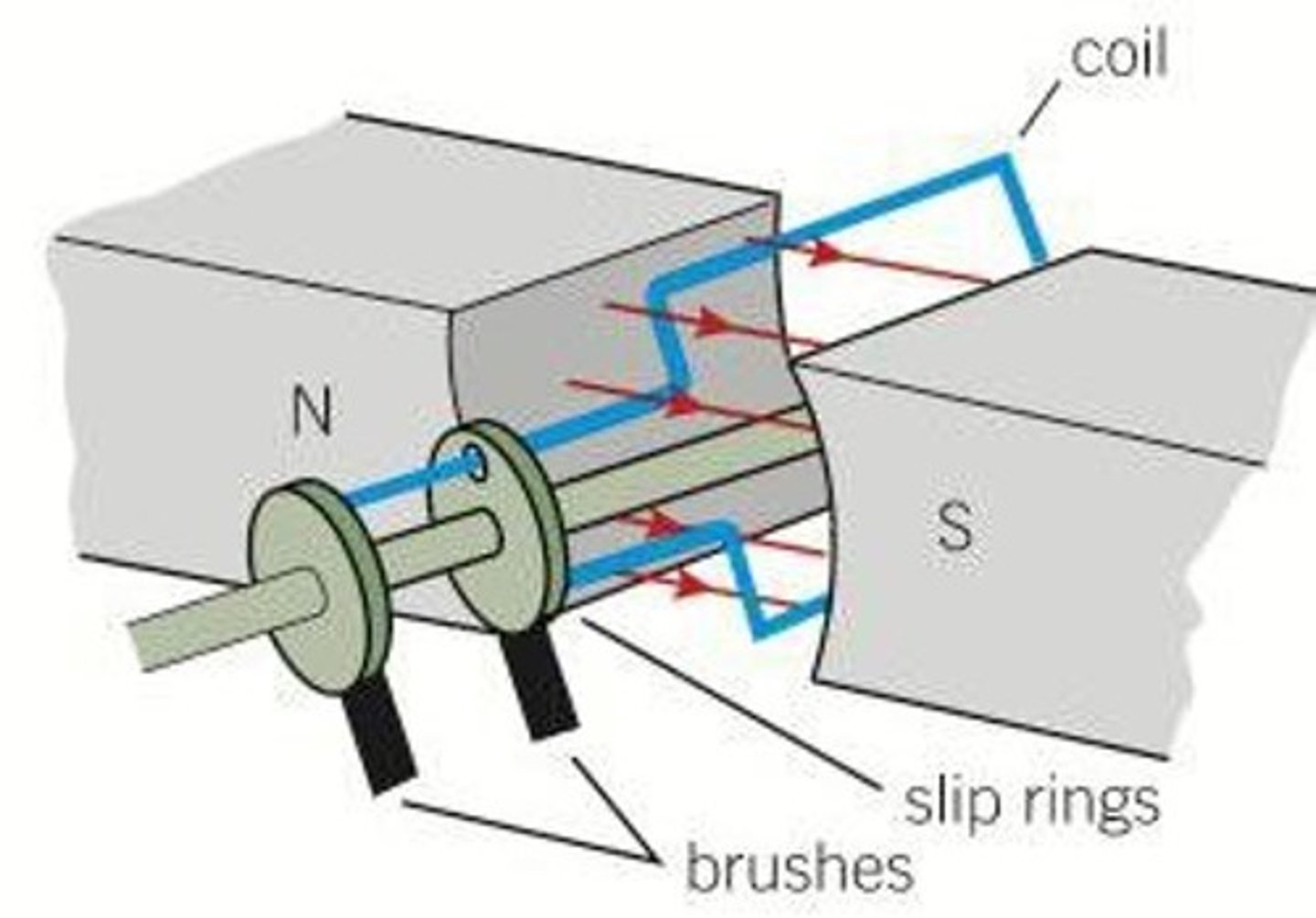
what do the graphs look like for A.C. generators for magnetic flux linkage over time and for emf over time
flux linkage = cos graph where the negative gradient is the e.m.f
emf = sin graph
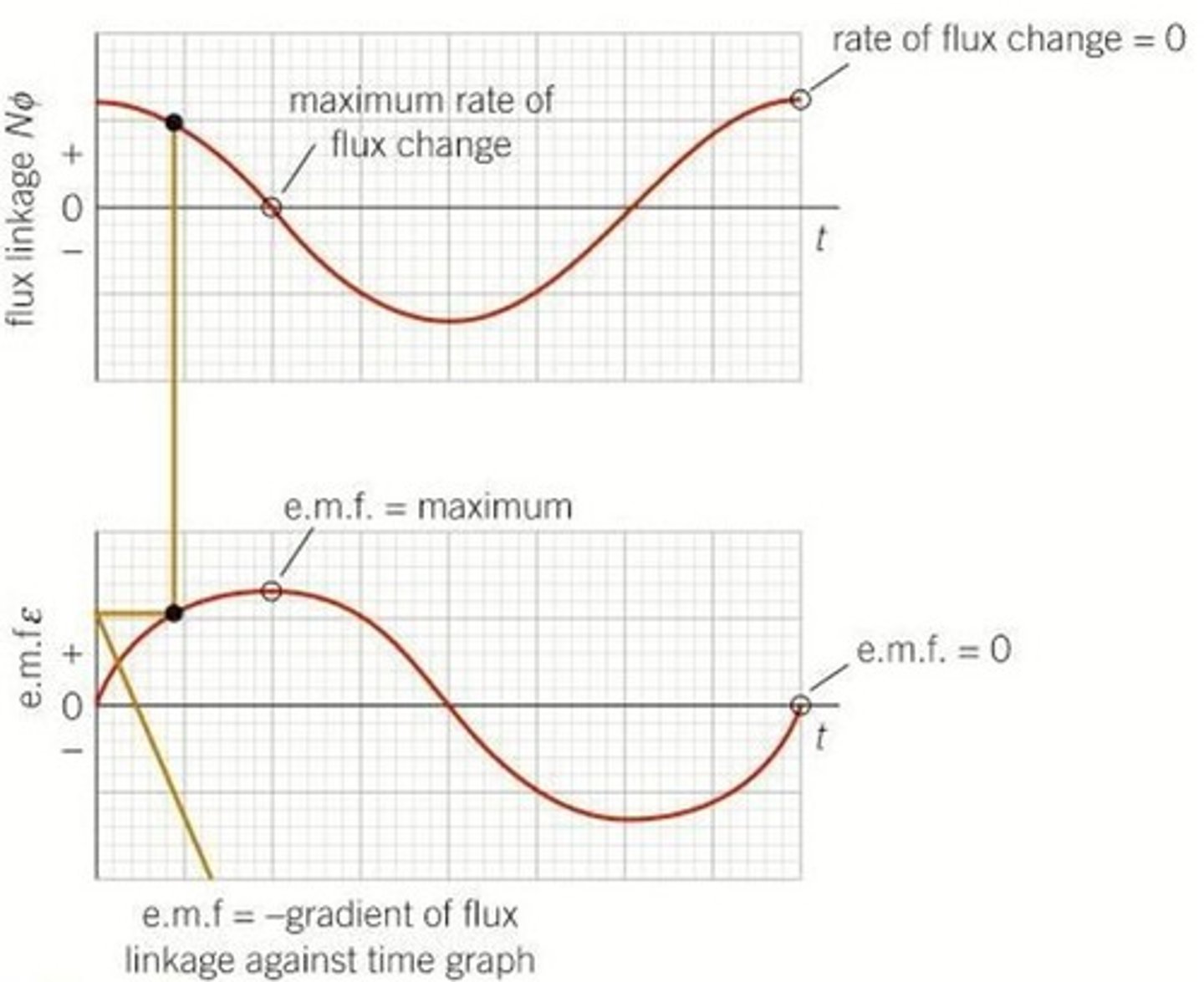
how can we increase the magnitude of the induced e.m.f. by the AC generator
- increase the number of turns in the coil
- increase the magnetic flux density
- increase the surface area A
- increase the frequency of rotation of the coil
give some examples of applications of electromagnetic induction
electromagnetic generators
wireless communications
wireless charging
step-up step-down transformers
what is a simple transformer comprised of?
- a laminated iron core
- a primary coil
- a secondary coil
explain how a transformer works
1. An alternating current flows through the primary coil.
2. This induces a changing magnetic field in the core.
3. This changing magnetic induces a current to flow in the secondary coil.
What is the turn-ratio equation for an ideal transformer?
Ns/Np = Vs/Vp
where s = secondary, p = primary
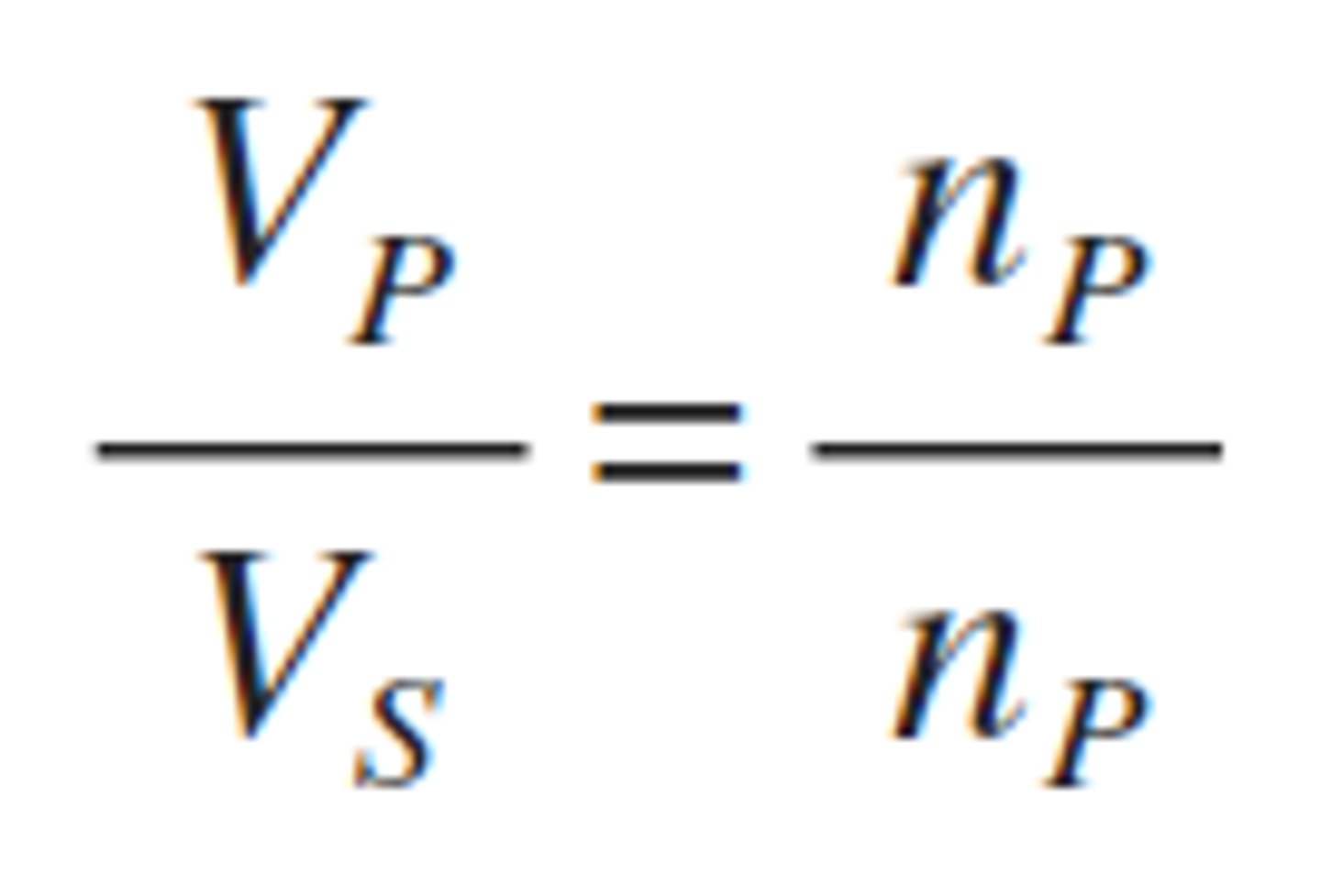
What does a step-up transformer do?
Using the turn-ratio equation, how can we achieve this?
what about for a step down?
increases voltage
more turns on the secondary coil than the primary coil
Ns >Np
∴ Vs>Vp
less turns on the secondary coil
Np>Ns
∴ Vp>Vs
for ideal transformers with 100% efficiency, what can we deduce about input power and output power?
so what can we deduce to make add onto the turn-ratio equation?
- they are the same, as no power is lost
P=IV
P=IpVp
P=IsVs
so Vs/Vp = Ns/Np = Ip/Is
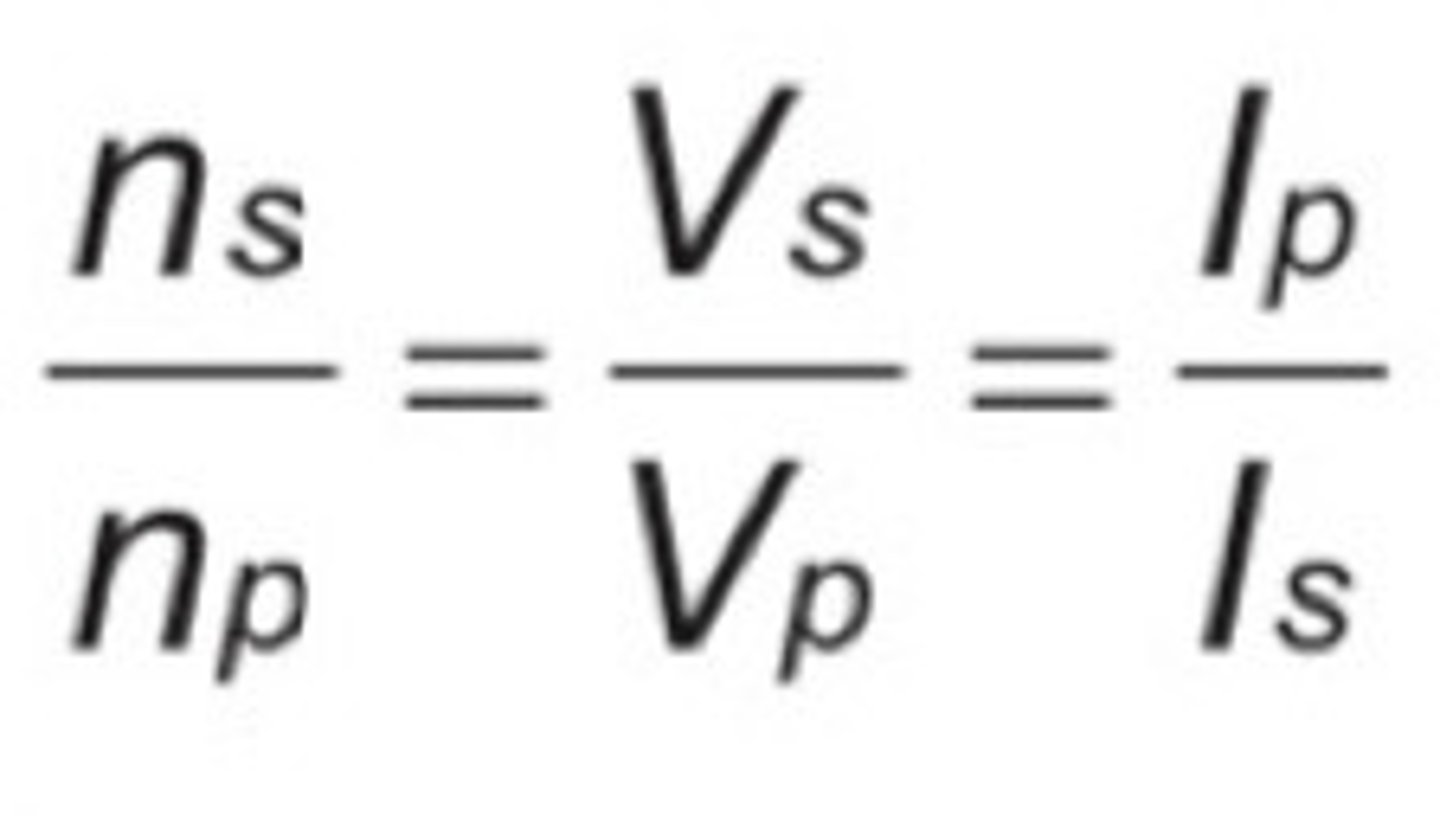
describe an experiment to investigate the turn-ratio equation for turns and voltage for a transformer
- join together 2 iron C-cores and wrap the wire around each to make the coils
- connect the primary coil to a signal generator and the secondary coil to a voltmetre
- turn on the supply and use a low voltage as transformers can increase voltage so you must keep it at a safe levle
- record the voltage across each coil and the number of turns you have
- keeping Vp the same, repeat the experiment with different ratios of turns
- you should find that for each ratio of turns, Ns/Np = Vs/Vp
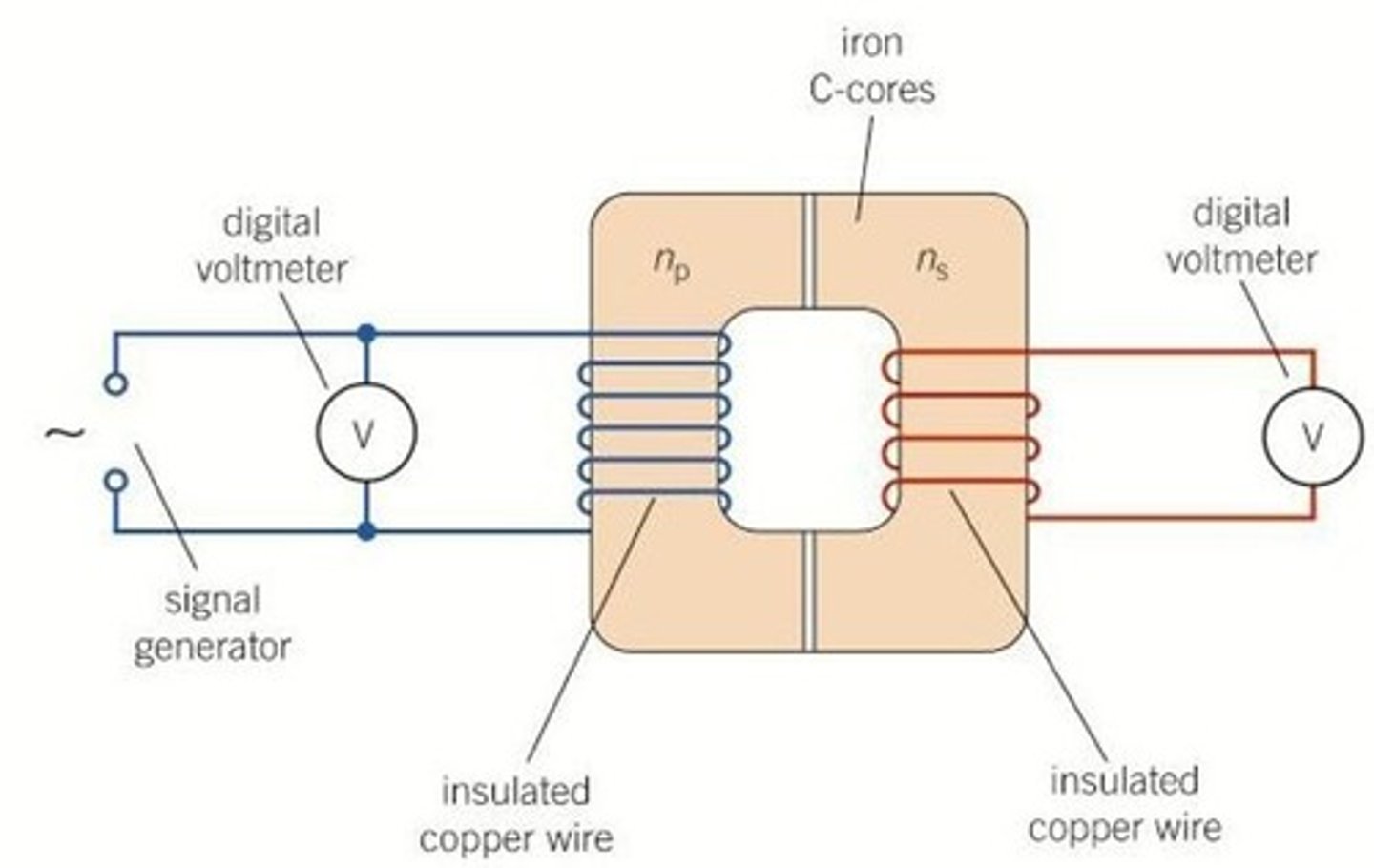
describe an experiment to investigate the turn-ratio equation for turns and current for a transformer
- join together 2 iron C-cores and wrap the wire around each to make the coils
- connect the primary coil to a signal generator, a variable resistor and an ammeter and the secondary coil to an ammeter and voltmeter
- leaving the number of turns constant, adjust the variable resistor to change the input current
- record current and voltage for each coil and then repeat this process for a range of input currents
- should find that Ns/Np=Vs/Vp=Ip/Is
what is one way to increase the efficiency of transformers
- use a low-resistance winding of wire to reduce power losses to thermal energy store